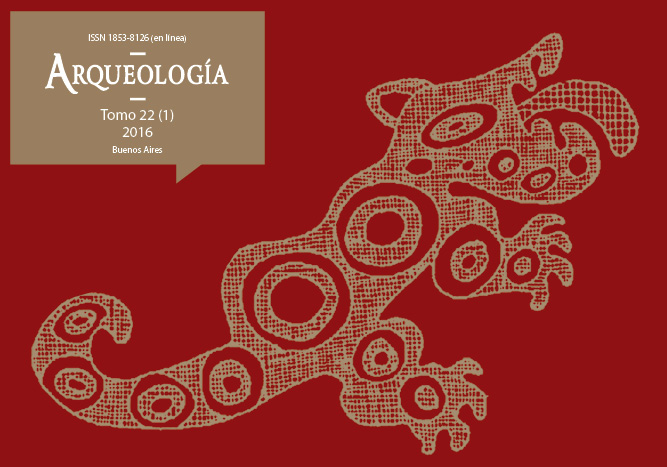Morfometría geométrica y representaciones rupestres: explorando las aplicaciones de los métodos basados en <i>landmarks</i>
Palabras clave:
Morfometría geométrica, Arte rupestre, Forma, Tamaño, Cuantificación
Resumen
El presente trabajo se propone comenzar a explorar la aplicación de las técnicas de morfometría geométrica basadas en landmarks para el estudio cuantitativo de la forma y tamaño de las representaciones rupestres. A modo de ejercicio metodológico y con el fin de mostrar las potencialidades analíticas de estos métodos, se analizó una muestra de 116 pinturas y grabados rupestres de la quebrada de Humahuaca y Puna (prov. Jujuy) correspondientes a figuras de camélidos de los sitios Playa Colanzuli, Media Agua, Sapagua y Barrancas, asignadas al Holoceno tardío. Así, en primer lugar se realiza una breve introducción al campo de la morfometría geométrica, sus orígenes, objetivos, distintos métodos y ventajas con respecto a la morfometría tradicional. Luego se describen los procedimientos técnicos de los métodos basados en landmarks y el protocolo de trabajo con las imágenes. Finalmente, se presentan tres tipos de análisis estadísticos multivariados factibles de ser implementados para describir: 1) las principales variaciones morfológicas de las representaciones (análisis de componentes principales), 2) las diferencias entre grupos de formas (análisis de variantes canónicas y test de hipótesis paramétricos y no paramétricos en base a distancias) y 3) la relación forma-tamaño (regresión múltiple).Descargas
La descarga de datos todavía no está disponible.
Cómo citar
Charlin, J., & Hernández Llosas, M. I. (1). Morfometría geométrica y representaciones rupestres: explorando las aplicaciones de los métodos basados en <i>landmarks</i>. Arqueología, 22(1), 103-125. https://doi.org/10.34096/arqueologia.t22.n1.2467
Sección
Artículos
Los autores/as que publiquen en esta revista aceptan las siguientes condiciones:
- Los autores/as conservan los derechos de autor y ceden a la revista el derecho de la primera publicación, con el trabajo registrado mediante Licencia Creative Commons 4.0 Internacional (CC-BY-NC-SA), que permite a terceros utilizar lo publicado siempre que mencionen la autoría del trabajo y a la primera publicación en esta revista.
- Los autores/as pueden realizar otros acuerdos contractuales independientes y adicionales para la distribución no exclusiva de la versión del artículo publicado en esta revista (p.e. incluirlo en un repositorio institucional o publicarlo en un libro) siempre que indiquen claramente que el trabajo se publicó por primera vez en esta revista.
- Se permite y recomienda a los autores/as a publicar su trabajo en Internet (p.e. en sus sitios web personales o en depósitos institucionales), tanto antes como después de su publicación en esta revista, siempre y cuando proporcionen información bibliográfica que acredite, si procede, su publicación en ella. De esta manera, pueden favorecerse intercambios productivos y a una mayor y más rápida difusión del trabajo publicado (vea The Effect of Open Access).



.png)

(1)13.png)






1.jpg)
1.png)
1.jpg)


13.png)
1.png)


(1)1.png)









